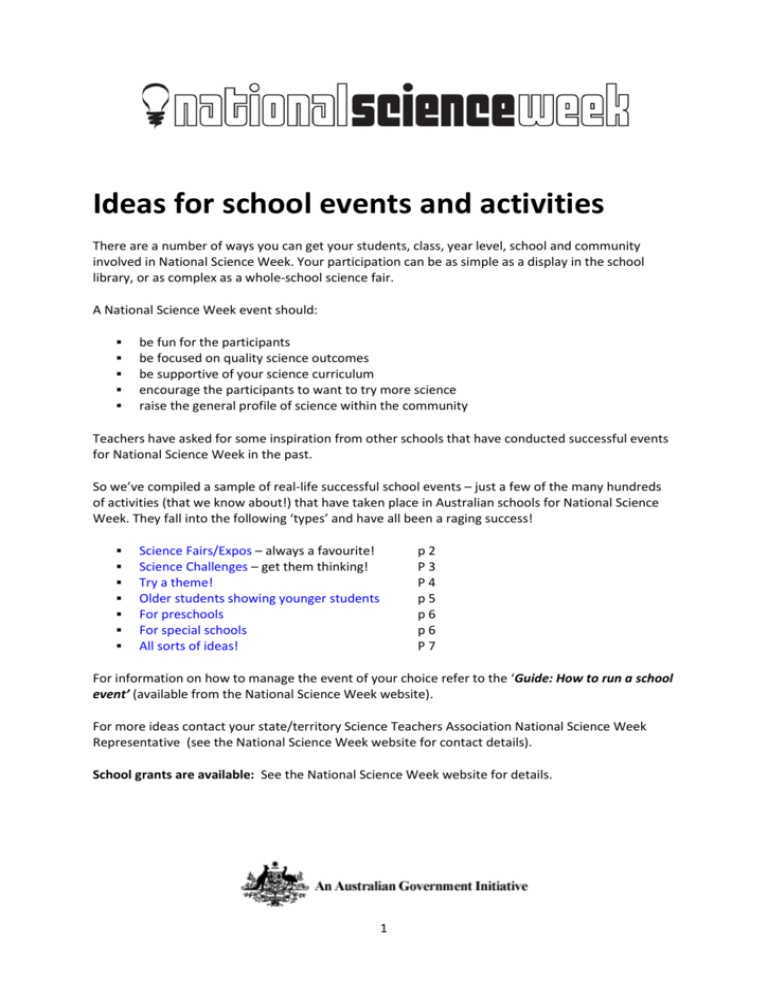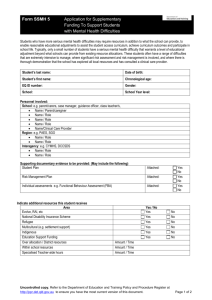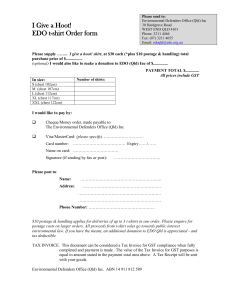Ideas for school events and activities
advertisement

Ideas for school events and activities There are a number of ways you can get your students, class, year level, school and community involved in National Science Week. Your participation can be as simple as a display in the school library, or as complex as a whole-school science fair. A National Science Week event should: be fun for the participants be focused on quality science outcomes be supportive of your science curriculum encourage the participants to want to try more science raise the general profile of science within the community Teachers have asked for some inspiration from other schools that have conducted successful events for National Science Week in the past. So we’ve compiled a sample of real-life successful school events – just a few of the many hundreds of activities (that we know about!) that have taken place in Australian schools for National Science Week. They fall into the following ‘types’ and have all been a raging success! Science Fairs/Expos – always a favourite! Science Challenges – get them thinking! Try a theme! Older students showing younger students For preschools For special schools All sorts of ideas! p2 P3 P4 p5 p6 p6 P7 For information on how to manage the event of your choice refer to the ‘Guide: How to run a school event’ (available from the National Science Week website). For more ideas contact your state/territory Science Teachers Association National Science Week Representative (see the National Science Week website for contact details). School grants are available: See the National Science Week website for details. 1 Science Fairs/Expos – always a favourite! Day-long community science fair This included a display of students' work from the Crest Awards (CSIRO), interactive stands and displays from industry partners (BHP Billiton Worsley Alumina, Doral Sands Ltd, Simcoa Industries) community partners (Bunbury Leschenault Rotary Club, City of Bunbury, Wooldridges Book store). Students also ran interactive workshops on their dolphin research, tours of our environmental centre, aquacultural facilities and our wetlands. Apart from our school, visitors came from the general community, the Mayor, representatives from each of our partners mentioned above and the Marine biologist along with the General Manager from the Bunbury Dolphin Center. Over a hundred primary school students from three different schools also attended. Students ran the interactive activities and showed the public and students how each activity operated. This included a range from using computerized robots to blowing up balloons with dry ice. (Newton Moore SHS, WA) Science Fair – Evening We held a science fair (from 5.00 pm – 7.00 pm) to showcase and celebrate the excellent science work that the children had completed in their classrooms. This work was displayed for the night. Teachers also set up interactive activities that linked in with the classroom science topic, so that children could actively engage with the activities at the science fair. Community groups were also invited to attend to have added displays and demonstrations to show how science is in our everyday life. A local newsagency brought books and science kits that could be purchased. There were also 2 competitions on the night - a guess the photo competition (photos of parts of objects from around the school) and a ‘make wind powered land yacht’ competition that generated a multitude of interest. The land yacht entries were still being trialled past 7.00 pm. (Bridport Primary School, TAS) Science Fair – Kinder to 10 Each class contributed a display with hands-on activities demonstrating various science investigations. Exhibits covered topics including mixing colour (Kinder), human touch (Prep/1), melting (Yr2), optics with lenses (Yr3), pneumatics (Yr4), sound insulation (Yr4/5/6), seed germination (Yr7), chemical reactions (Yr9), acids and the pH scale (Yr10). (King Island DHS, TAS) 2 Science Challenges – get them thinking! Bridge building competition (Years 4–7) Bridge building based on natural and processed materials. The challenge was to build a bridge to span 40cm to carry a matchbox car. Yrs 4–5 used straws and masking tape; Yrs 6–7 used spaghetti and hot glue. Students were given a 2-hour block and worked in teams of 3 to create the bridges. (Logan Reserve SS, QLD) National Science Week Community Challenge Cowra High School (NSW) invited local schools, businesses, council and community groups to complete a series of science and engineering tasks. This was an evening event from 6.00 pm – 10.00 pm. The two engineering tasks were collaborative tasks and promoted group engagement. Teams needed to construct a water filter and were only provided with 2 plastic bottles and scissors. Each group was given $45 in ‘Monopoly’ money and could purchase substrates (sand and gravels), stockings, cotton balls, elastic bands and charcoal. They could only spend as much as they had and the more they spent the more points they lost, however, the clearer and purer the water the more points they earned. Other students tested the water for clarity and purity by doing simple tests. The second engineering challenge was to construct a ball-bearing roller coaster where groups had to construct a roller coaster to deliver a ball bearing from table height to the floor in the longest time possible. A series of obstacles had to be included (loops, slides and a change in direction) or the group lost points. (Cowra High School, NSW) Science and Engineering Challenge ‘Constructarama’ was a week-long challenge for Years 7-9 that emphasized teamwork and creativity, and included lunch-time activities and demonstrations. Students were given a science or engineering problem to solve (e.g. building a bridge, catapult or balloon-buggy), provided with the equipment and were required to solve the problem in the time allowed. Teams competed over the course of several weeks for the Grand Prize, and results were discussed with each class. (Blackfriars Priory School, SA) 3 Try a theme! Healthy Garden beds in the permaculture garden. After one year it was time to investigate how healthy the garden beds were and how well the plants were growing through observation and soil tests. From a choice of nine garden beds four were chosen on the basis on the length of time they had been developed i.e. from well established to second planting to first plantings. The groups collected soil samples, which they used to perform the following tests: pH, turbidity and soil content evidence of micro-organisms. The students also measured some plants with the intention of measuring again at a later date to determine their growth rate. (North Arm SS, QLD) Fantastic Flight Festival. All students (Prep to Yr 6) participated in rotational year level activities involving scientific experimentation related to the concepts of flight. Students were given the opportunities to create and test a range of flight resources including parachutes, rockets, paper planes, choppers, flying foxes, slingshots, hot air balloons and delta darts. Lunchtime activities were developed and included frisbee, vortex, rocket and ball activities, kite making and flying, peg plane design and construction, and a huge school wide paper plane making and flying competition. A wide range of flying animal specimens and model flying machines (Aero Model Soarers Club) and a range of live birds from the local budgerigar society were displayed for student learning, observation and sketching. A spectacular display and commentary on kite flying (Qld Kit Flying Society) was presented and to culminate the week of activities, two skydivers used parachutes to drop onto the school oval. (Capalaba State College, QLD) 4 Older students showing younger students Science Spectacular Older students demonstrated a number of different science experiments that the younger students rotated through over an hour. The experiments demonstrated that science is fun and applicable to many areas of everyday life. Experiments included: Smartie Party – discover how Smartie colours spread but don’t mix straight away, in water. Milky Rainbow – surface tension discoveries with milk, food colouring and detergent. Mini volcano – vinegar, bicarb soda, detergent and food colour creates lots of fun! A Chilly Recipe – a great endothermic reaction with bicarb soda and citric acid. Lava Lamp – oil, water, food dye and salt…oil and water don’t mix! Soap Boats – water tension with water, detergent and mini ‘boats’. Humpty Dumpty – discovering the structural strength of eggshells. (St. John Vianney School, ACT) Science Roadshow to local primary schools Three staff and eighteen fantastic Year 7 students visited our five feeder primary schools to promote science by running activities with eleven Year 5/6 classes. The theme was biodiversity and our focus was the importance marine biodiversity and how we can affect it through fishing. In smaller groups the Year 7 students lead groups in activities where they learnt how scientists identify and classify organisms, how they keep track of population sizes and how chemicals can affect their habitats. The finale was a fish dissection demonstration. (Kingston High School, TAS) 5 For preschools Science Explorers workshop The preschool playroom became a science workshop with equipment and instructions on each table allowing the children and their parents to investigate and partake in different science experiments. Some the children could do themselves, others needed the parent and child to work together. (Lilydale North PS, VIC) For special schools Mackillop Catholic College students ran activities for our students - giant bubbles, rats, stick insects, robots (dancing, soccer, search and rescue), explosions and the Van de Graaff generator. We also set up different activities – magnets, ant 'circus', worm farm, prisms, crystals and rockets. Students with special needs often have difficulty in communicating or participating in group activities – the Mackillop students talked knowledgeably about the activities, but more importantly, engaged with our students in an incredibly caring and successful manner – interactions were wonderful to observe. Our students, the very young to the 18 year olds, found activities of interest – foil pie dishes flying around (Van de Graaff generator), intriguing stick insects and rats, robots, popping and fizzing of the hydrogen and the giant bubbles. The Expo not only sparked immediate enthusiasm, but also provided our staff with a rich stimulus for engaging students in follow-up activities, which will far outlast the event itself. Discussion and planning took place between the two schools (high students and teaching staff) over many weeks. Mackillop students were briefed about the types of students that they would be working with. Communication between the two schools was excellent - a key factor in ensuring that appropriate activities were selected. A symbolised activity booklet was prepared and distributed in advance. This provided students with a visual representation to prepare them for an unusual event (very important for students with ASD). Students were given a sticker for their booklet after participating in each activity. A space was provided on each page for inclusion of a photo of the activity (to be completed during follow-up work). (Southern Support School, TAS) 6 All sorts of ideas! Outdoor Science Laboratory Growing bacterial cultures using rhodospirillum rubrium, extracting DNA from strawberries and bananas, making water-powered rockets, completing fitness tests, building electrical circuits and testing a range of products to see if they conduct electricity, the development of a native garden, a farmers market to sample the school’s Ag farm produce, wine making and forensics. (Charters Towers SHS, QLD) Science sculpture exhibition Each class from PP –Yr 7 designed and created a science sculpture made from recyclable materials. All classes visited the exhibition and older students were buddied up with younger students. Each child received a program with an outline of each sculpture and was asked to complete a voting slip. They voted for their favourite sculpture, the one with the best environmental message and the one with the best use of recycled materials. The local Member of Parliament presented certificates and fruit trees (for our vegetable garden) at assembly. (Applecross PS, WA) Science Week lunch We had a special science week lunch at the tuckshop that included items such as Microchips with lava, flavoured H2O, protein wrapped in emulsified sheets of carbohydrates and solidified H20 with glucose. We also had our district science facilitator talk about biodiversity at our upper and lower school assembly and she conducted some science experiments. (Cooroy SS, QLD) Sundial Construction Joint project between Ipswich SHS and Brassall SS (QLD) to construct an analemmatic sundial on the Brassall site. Activities included planning and obtaining field data, constructing models, trialling sundials and eventually construction. (Ipswich SHS, Brassall SS, QLD) Marine Debris Survey Studying the effects of plastic in our ocean and the effect on marine food webs. As a school we went to our local beach and conducted a marine debris survey to send the local WWF. The school’s P and C, family members, local beach residents, an army officer from the local army base and our Adopt-a- 7 Cop helped us. The local indigenous group is looking at letting the school ‘adopt’ the beach with a proper hand-over ceremony! (Moresby SS QLD, One teacher school) Science Boxes Science Boxes were made that included all the everyday items that could be used for science activities during Science Week. Teachers are encouraged to run experiments in their classroom and look at different ways of recording results. From there, teachers will use other ‘everyday items’ to conduct other simple science experiments. Teachers were also encouraged to contribute these items to the box for other teachers to use. (Mt. Warren Park PS, QLD) Hands-on science stall Every class in the school developed their own hands-on science stall that was suitable for all year levels to engage in. All of the classes set up their stall before school in the school hall and rostered students on to man their stall throughout the day. Every class was allocated a 45 minute time slot to explore the 31 stalls. Students were highly enthusiastic and enjoyed the wide variety of activities on display - from parachutes to oil spills to pepper racing. (Mt. Warren Park PS, QLD) Vegetable Garden As a school we planned a vegetable garden, rotary hoed it, spread a ute load of manure over it, purchased a bale of straw for compost, divided the garden up into beds and put up fence lines for climbing plants such as peas. Individual classes selected seeds to plant for this time of the year and started seedlings in pots in the classrooms. Other classes planted directly in the garden. As a school we did many other activities including preparation and cooking of garden/ farm products, such things as separating milk, making cheese, cooking bread, making soup. (Quandialla PS, NSW) Community Science Museum The Community Science Museum was an educational and interactive museum organised in the school community hall. The museum ran for Science Week and was free of charge to all local, state and independent primary and secondary students and teachers as well as members of the Charters Towers community. The science and agricultural departments delivered practical demonstrations and prepared interactive exhibits in various fields of science. The museum featured exhibits from local and regional agencies, including LANDCARE: Charters Towers, Great Barrier Reef Marine Park 8 Authority (GBRMPA), Museum of Tropical Queensland (MTQ), NQ Dry Tropics and the Tropical Weeds Research Centre. (Charters Towers SHS, QLD) Science Video Students in Years 5 and 6 got into pairs and researched and filmed a one-minute video of a science experiment of their choosing. The film is going to be entered into the ‘60 Second Science’ competition and be shown to the school community in a presentation evening. (Roseneath PS, TAS) A bit of everything A week of science at Bajool State School with science lessons and demonstrations every day. For example, we had a science cooking day where we investigated foods and their properties and also the science involved in preparing food. On the Wednesday of Science Week we had a family science night. On the Thursday we ran a Science Cluster Day inviting local schools to attend. Our small school of 32 students grew to over 100 with parents and community members also joining us. Dr Peter Eastwell also provided some PD for attending teachers. Local businesses provided sponsorship for our Science Week. (Bajool State School, QLD) 9





